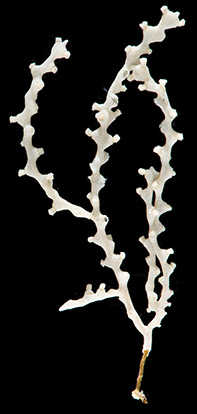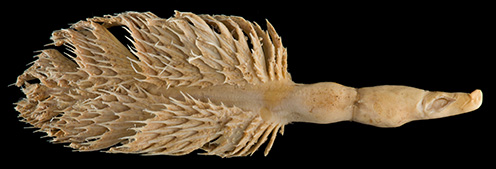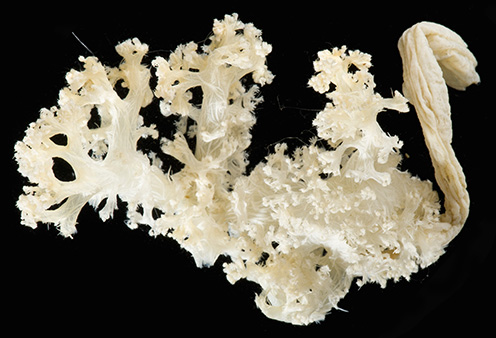Cnidaria - Ctenophora collection

Dendronephthya mortenseni Holotype, Tixier-Durivault & Prevorsék 1959
Curator
Collection manager
About the collection
The collection comprises representatives of all the major groups worldwide, both benthic and pelagic, in shallow waters as well as in the deep sea. Coverage varies from one geographical region to another.
It centers on the North Atlantic (Iceland, The Faroes, Scandinavia), and the Arctic (Greenland), but regional collection efforts in other parts of the world have resulted in extensive materials (The West Indies, West Africa, Indonesia, New Zealand).
The Hydroida, the Scyphozoa, the Actiniaria, many of the Octocorallia, and the Ctenophora are stored in alcohol, while a large part of the Octocorallia and nearly all Scleractinia are dried. Some materials of older date have been sorted, but were never worked up. Wet samples provided after 1900 are generally supposed to have been treated with formaldehyde. The sampling efforts were scattered over time, and carried through on expeditions with different main objectives and using different kinds of gear.
More than 200 publications have fully or in part been based on specimens in the collection, the oldest dating back from 1775.

Swiftia rosea subsp. pallida Type, Madsen 1970
Cnidaria - Ctenophora collection in numbers
- Estimated number of specimens/collections: More than 14,000 lots plus hundreds of slides. Overall conservative estimate of lot numbers for each group is: 3,300 hydrozoans, 4,300 scyphozoans, 5,000 anthozoans, 600 cubozoans, 750 siphonophores and 300 ctenophores
- Types: Almost all currently available types have been registered. Presently, there are 98 holotypes, 7 lectotypes, 1 neotype, 15 paralectotypes, 64 paratypes, and 153 syntypes
- Digitally available specimens: There are 2,213 currently registered specimens: 1,169 Anthozoa, 1 Cubozoan, 1,037 Hydrozoa, and 6 Scyphozoa
- Percentage digitized: Ca. 10% of the identified material.
Particular strengths
- The Cnidarian fauna of Greenland
- The Cnidarian fauna (both benthic and pelagic) of all depths of the northern Atlantic
- Hydromedusae from the North Sea and Danish waters
- Siphonophora (although many are unidentified)
Important subcollections
The scleractinian corals collected by Forsskål in the Red Sea in 1761 comprise quite a number of type specimens. Especially significant with respect to size and coverage of the diversity of the investigated areas are the collections from the Danish “Ingolf” Expedition 1895-96 (Iceland and southern Greenland), the “Godthaab” Expedition 1928 (Davis Strait and Baffin Bay), the “Dana” Expedition 1928-30 (Worldwide), the “Galathea” Expedition 1950-52 (Worldwide), and Th. Mortensen's Kei Expedition 1922 (Indonesia).
History
The building up of the collection dates back to the 1870’es. Around this time a tradition was created by the then professor of zoology, Japetus Steenstrup, who contacted officials in the Danish colonies and captains of merchant vessels asking them to provide and send home interesting specimens. During the following decennia the Zoological Museum received scattered and somewhat fortuitous materials from Greenland, Iceland, The Faroes, The Virgin Islands (West Indies), The Mediterranean and East Asian waters.
More comprehensive and informative collections were provided on regular expeditions and from collection done by young naturalists liable for service on naval and Fishery Inspection vessels. Examples of Danish expeditions where such materials were provided are the “Dijmphna” Expedition 1882-83 (Kara Sea); the “Fylla” cruises 1884 and 1886 (West Greenland); the “Ingolf” Expedition 1896-96 (deepwater around southern Greenland, Iceland and The Faroes); the “Hekla” Expedition 1898-1900 (The Carlsberg Foundation’s East Greenland Expedition); the “Danmark” Expedition to Northeast Greenland 1906-08, the “Tjalfe” cruises 1908 and 1909 (West Greenland); the cruises of the project The Zoology of the Faroes 1924-27; the “Dana” Expedition 1928-30 (around the World), the “Godthaab” Expedition 1928 (West Greenland); the “Atlantide” Expedition 1945-46 (West Africa); and the “Galathea” Expedition 1950-52 (around the World).

Pteroeides esperi var. angustifolium Type, Kölliker 1872
Also, one very remarkable one-man contribution has resulted in accession of comprehensive materials of invertebrates, including Cnidaria. It was accomplished by Th. Mortensen (1868-1952), inspector at the Zoological Museum, who between 1899 and 1930 travelled to many parts of the World collecting in shallow waters. Many of his materials originate from localities which for different reasons are inaccessible or difficult to visit today with the aim of collecting.
Historically, the cnidarian/ctenophore collection has only part of the time been curated by specialists. C.F. Lütken (1827-1901) became assistant at the museum in 1851, and over time worked with different animal groups, retiring in 1899; within the Cnidaria he was interested in antipatharians and scleractinians. H. Jungersen (1854-1917) became assistant in 1883, and until his death worked with several animal groups, among them octocorals. P.L. Kramp (1887-1975) took responsibility for the collection from 1917 until his retirement in 1957; he worked especially with hydroids. K.W. Petersen (1935 -) came to the museum in 1965 and was curator of the collection until 1988, when he went to the Exhibition Department; he worked with hydroids.
Other Danish zoologists who worked with different corals are F. Jensenius Madsen and O.S. Tendal. A number of foreign specialists have worked up substantial parts of the collection, viz. O. Carlgren, C. Crossland, E. Deichmann, M. Sears, P. Schuchert, and H. Zibrowius.

Roxasia fragilis Holotype, Tixier-Durivault & Prevorsék 1960
